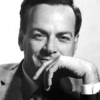Richard P. Feynman

Richard P. Feynman
Richard Phillips Feynmanwas an American theoretical physicist known for his work in the path integral formulation of quantum mechanics, the theory of quantum electrodynamics, and the physics of the superfluidity of supercooled liquid helium, as well as in particle physics for which he proposed the parton model. For his contributions to the development of quantum electrodynamics, Feynman, jointly with Julian Schwinger and Sin-Itiro Tomonaga, received the Nobel Prize in Physics in 1965...
NationalityAmerican
ProfessionPhysicist
Date of Birth11 May 1918
CountryUnited States of America
The internal machinery of life, the chemistry of the parts, is something beautiful. And it turns out that all life is interconnected with all other life.
It has been discovered that all the world is made of the same atoms, that the stars are of the same stuff as ourselves. It then becomes a question of where our stuff came from. Not just where did life come from, or where did the earth come from, but where did the stuff of life and of the earth come from?
The fact that the colors in the flower have evolved in order to attract insects to pollinate it is interesting; that means insects can see the colors. That adds a question: does this aesthetic sense we have also exist in lower forms of life?
It turns out that all life is interconnected with all other life.
There in wine is found the great generalization: all life is fermentation.
I think a power to do something is of value. Whether the result is a good thing or a bad thing depends on how it is used, but the power is a value.
Tell your son to stop trying to fill your head with science — for to fill your heart with love is enough.
The first principle is that you must not fool yourself and you are the easiest person to fool.
You have no responsibility to live up to what other people think you ought to accomplish. I have no responsibility to be like they expect me to be. It's their mistake, not my failing.
Working out another system to replace Newton's laws took a long time because phenomena at the atomic level were quite strange. One had to lose one's common sense in order to perceive what was happening at the atomic level.
With the exception of gravitation and radioactivity, all of the phenomena known to physicists and chemists in 1911 have their ultimate explanation in the laws of quantum electrodynamics.
When I would hear the rabbi tell about some miracle such as a bush whose leaves were shaking but there wasn't any wind, I would try to fit the miracle into the real world and explain it in terms of natural phenomena.
What goes on inside a star is better understood than one might guess from the difficulty of having to look at a little dot of light through a telescope, because we can calculate what the atoms in the stars should do in most circumstances.
We seem gradually to be groping toward an understanding of the world of subatomic particles, but we really do not know how far we have yet to go in this task.